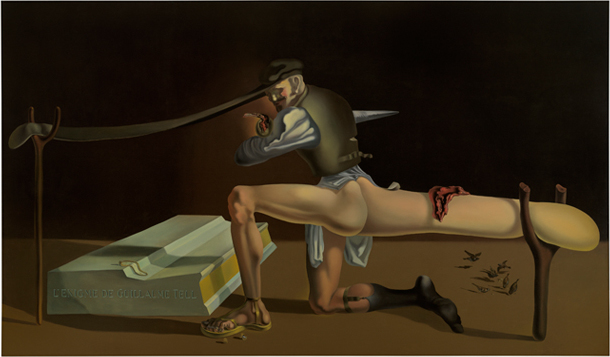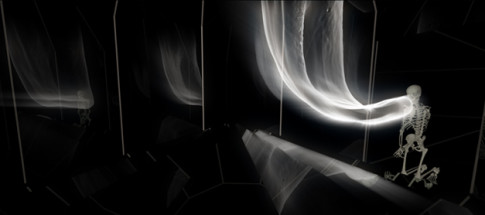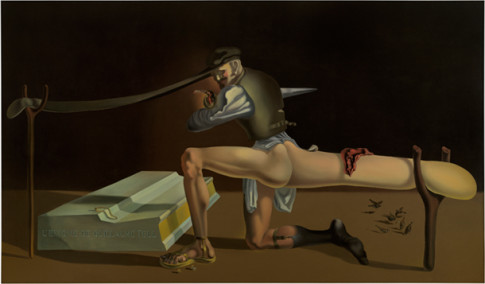
Salvador Dalí, Wilhelm Tells gåta, 1933 © Salvador Dalí, Fundación Gala-Salvador Dali / Bildupphovsrätt 2012
Douglas Coupland about THE SUPERSURREALISM
What is THE SUPERSURREALISM?
On American reality TV shows they’ll sometimes interview a teenager
about something that’s just happened to them on the show …perhaps this
teenager has just finished eating a smoothie made of tropical insects, or
perhaps they’ve just karaoked with Demi Moore. More often than not these
young people will say, “It was so …surreal.” This comes as a shock to
me because these are people who can’t locate France on a world map or
multiply 8 x 7, and yet here they are using the word ‘surreal.’
Awesome — it was so surreal.
So what exactly is it these young people are actually meaning
when they stare at a game show host and say, “Wow, that was so surreal
— I can’t believe I just smashed cantaloupe melons with Grace Jones”?
Traditionally, surrealism is about images and symbols inside our brains
free-associating with themselves without the burden or agenda of day-today
consciousness — not quite a dream state — rather, a recognition that
there are deeper levels of identity available that can be creatively accessed
with the end in mind of crystallizing new and revealing mental states in the
form of an art work or artistic experience.
The collective assumption here is that there actually do exist
deeper and truer versions of ourselves — wiser, truer versions — if only we
could listen attentively enough, we might become better humans, far more
engaged with being alive on the planet, less sexually screwed up, more
fully creative: hence Freud and everything since. But there are potential
errors in this system of thinking.
In Vienna in the mid-1990s I was giving a lecture at the Vienna
Literary Festival, and the theme that year was money. When I came on
stage, I said, “It’s a pleasure to be visiting Vienna, the place where the
subconscious was invented.” I waited a second for that to sink in — there
was a bit of a murmur, at which point I said, “Whoops. What I meant to say
was that it’s a pleasure to be in Vienna, the place where the subconscious
was discovered.” That made everyone quiet and happy; the existence of
the subconscious was nonnegotiable. Later in that same talk I mentioned
how the subconscious is actually a lot like Antarctica: it’s huge, we know
very little about it, it’s incredibly hard to reach and it can only be visited
with lots of money. Rather than getting a chuckle, people rubbed their
chins and made body language to the effect of, “This Canadian writer chap
has made a very good point. Bravo.”
After Vienna that I began thinking about the subconscious on
a scientific level: id, ego and super-ego. But why just the three levels?
Maybe there are six levels of self. Or a few hundred. Or an infinite number.
To date I’ve read no satisfying scientific reason to assume a mere three
levels of self. It may well be true; I just don’t believe it. It’s things like SSRI
antidepressants and other pills developed in the last two decades that
makes me wonder if the psyche is infinitely layered and ever evolving.
Concepts change. An example? We once believed that as adults we had
all the brain cells we’re ever going to have inside our skulls, and that from
puberty on, we can only lose them. But no, we all grow about 10,000 new
cells a day, with the caveat that unless we use them, these new cells are
reabsorbed back into the body (which is kind of surreal.) Serves us right
for not using them.
But here I’ve only discussed levels of self and identity looking inward.
What makes 2012 so much more interesting than 1912 is that we now have
this thing called the Internet in our lives, and this Internet thingy has, in the
most McLuhanistic sense, become a true externalization of our interior selves:
our memories, our emotions, so much of our entire sense of being and
belonging. The Internet has taken something that was once inside us and put
it outside of us, has made it searchable, mashable, stealable and tinkerable. The Internet, as described by William Gibson, is a massive consensual
hallucination, and at this point in history, not too many people would disagree.
But let’s go back in time a few decades. Let’s go back to 1981,
my second year in art school, pre-Prozac, pre-personal computer
pre- many things. I remember being told by instructors that changing
the channels on a TV set just to see what juxtapositions it throws
back at you was postmodern because one wasn’t dealing with a true
subconsciousness here, it was a pseudoconsciousness, and therefore
not interesting. I disagreed violently, and continue to violently disagree
with this assumption. It presupposes an inability of human consciousness
to expand outside of itself; Greece and Rome had civilizations, and
Vancouver in 1981 had changing TV channels; older civilizations may be
more glamorous and enduring, but ontologically, they’re no different than
TV channel changes. TV is ephemeral; the Coliseum is concrete but still
corroding; it’s only a matter of time frames. Collective manifestation of the
inner world can, and does, take infinite forms.
Which gets us back to surrealism proper, and it gets us back
to teenagers on US TV saying, “Wow, man, that was the most surreal
experience.” What these teenagers are alluding to, it seems to me, is that
their psyches have been put through an external identity randomizer —
they’ve been pulled through the churn. The game show or reality show
or what have you, has taken the teenager on a tour through externalized
layers of reality that are utterly new since 1912, 1981 or even 2000.
Their psyches have been whisked through the collective dream and
the collective subconsciousness, yielding just the same sorts of tingly
sensations one might have had looking at a Dali or a Magritte in the 1920s
or 1930s.
It’s also important to remember that Surrealism was a movement.
In the early 20th century, movements lasted decades. By the sixties they
lasted two years. Nowadays we don’t even have movements; we have
memes. Memes last a day or two and then vanish. Were surrealism to
have been invented today, it’s be a very cool web site that throws images
and clips together and makes your head feel tingly. “Have you gone to
supersurrealism.com? It’s like a Japanese TV game show except it’s for
real and it’s exploding right in front of your face. It’s totally supersurreal.”
Douglas Coupland


